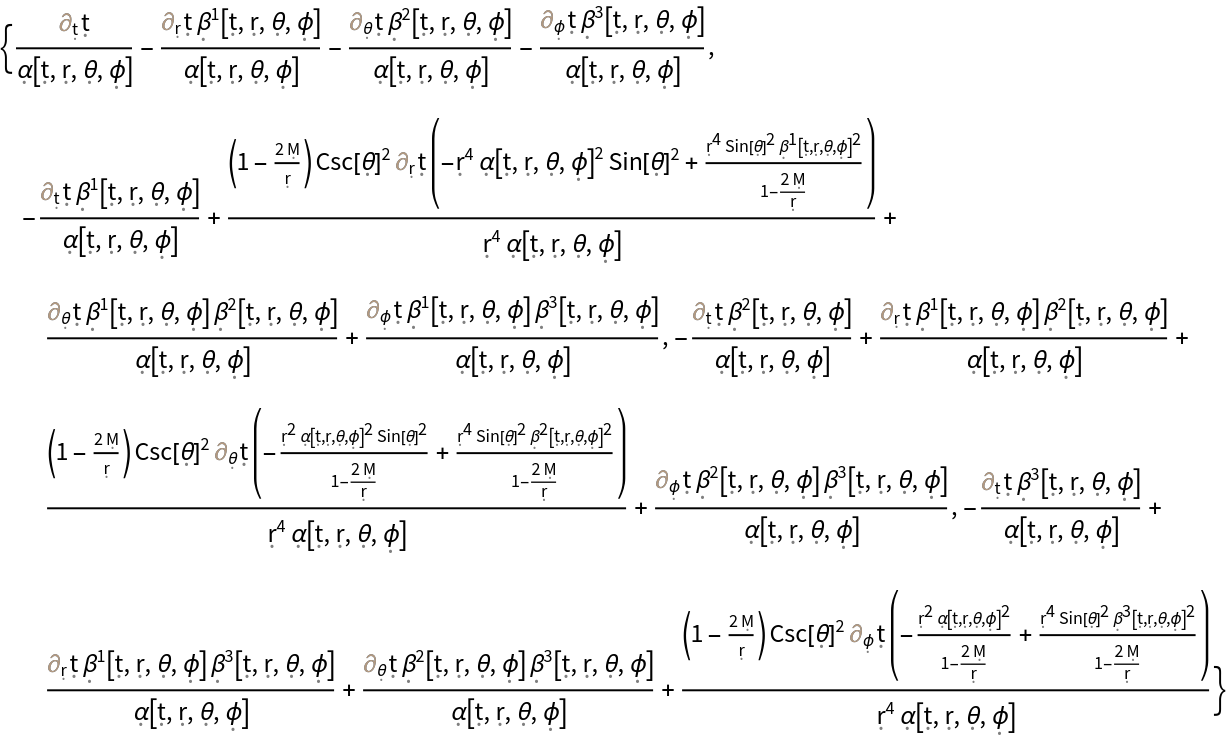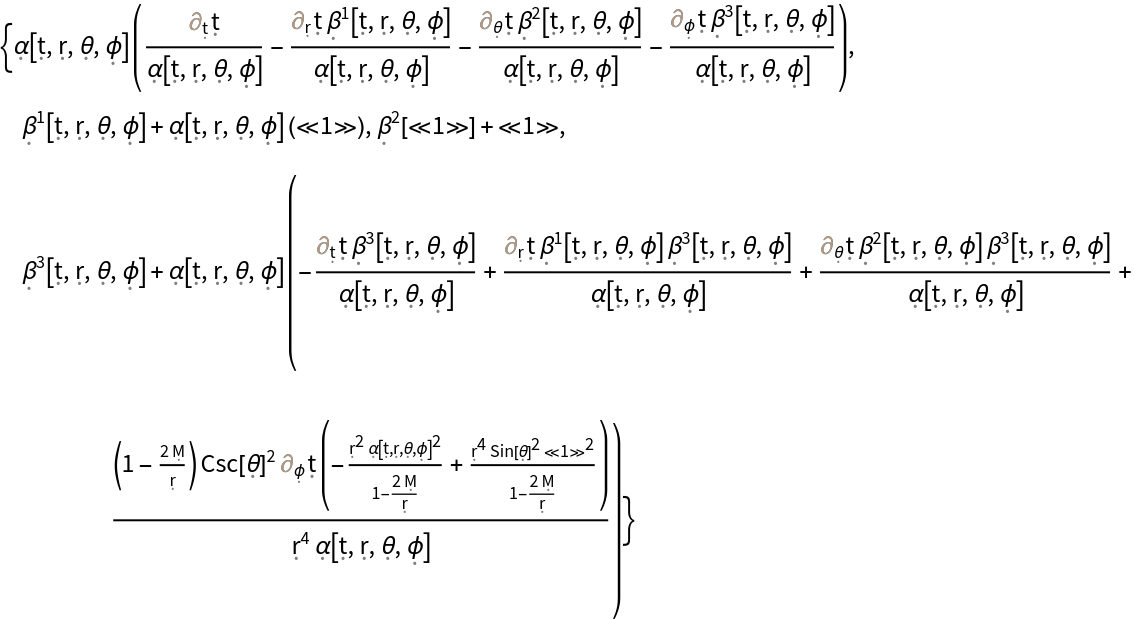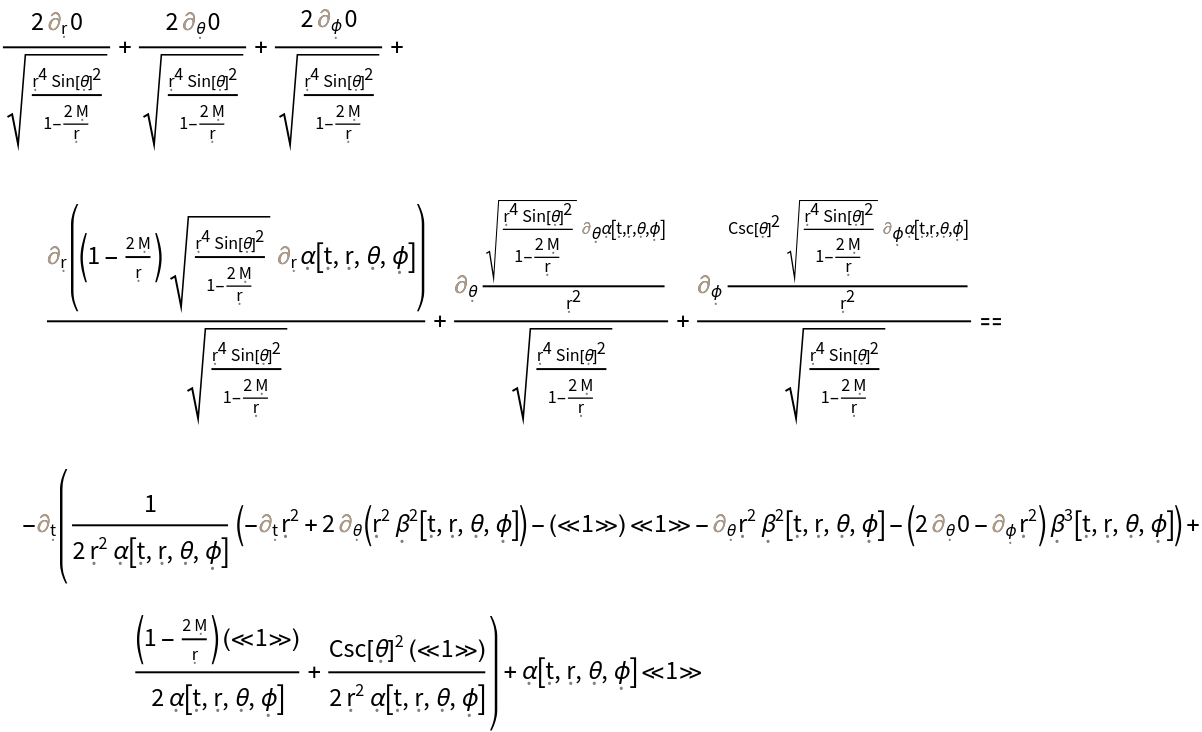Basic Examples (4)
Perform an ADM decomposition for the Schwarzschild metric (e.g. for an uncharged, non-rotating black hole with symbolic mass "M") in standard spherical polar coordinates, using the most general/maximally-unconstrained choice of gauge:
Show the spatial metric tensor for the (maximally-unconstrained) ADM decomposition of the Schwarzschild metric:
Show the spacetime metric tensor for the (maximally-unconstrained) ADM decomposition of the Schwarzschild metric:
Show the lapse function for the (maximally-unconstrained) ADM decomposition of the Schwarzschild metric:
Show the shift vector for the (maximally-unconstrained) ADM decomposition of the Schwarzschild metric:
Show the future-pointing, timelike unit vector normal to spacelike hypersurfaces in the (maximally-unconstrained) ADM decomposition of the Schwarzschild metric:
Show the condition on the lapse function that must hold in order to achieve geodesic slicing in the (maximally-unconstrained) ADM decomposition of the Schwarzschild metric:
Show the list of conditions on the shift vector that must hold in order to achieve normal coordinates in the (maximally-unconstrained) ADM decomposition of the Schwarzschild metric:
Show the condition on the lapse function that must hold in order to achieve 1+log slicing in the (maximally-unconstrained) ADM decomposition of the Schwarzschild metric:
Show the condition on the lapse function that must hold in order to achieve 1+log slicing in the (maximally-unconstrained) ADM decomposition of the Schwarzschild metric, with all algebraic equivalences imposed:
Perform the same ADM decomposition for the Schwarzschild metric in spherical polar coordinates, but with numerical mass 1, time coordinate symbol t, spatial coordinate symbols r, a1 and a2, using a partially-constrained choice of gauge (defined in terms of scalar functions a and b):
Show the spacetime metric tensor:
Show the list of equations of motion describing the evolution of the extrinsic curvature tensor with respect to coordinate time t for the (partially-constrained) ADM decomposition of the Schwarzschild metric:
Show that the evolution equations for the (partially-constrained) ADM decomposition of the Schwarzschild metric all hold identically:
Show the list of Gauss equations relating projections of the spacetime Riemann curvature tensor to components of the Riemann curvature tensor over spacelike hypersurfaces for the (partially-constrained) ADM decomposition of the Schwarzschild metric:
Show that the Gauss equations for the (partially-constrained) ADM decomposition of the Schwarzschild metric all hold identically:
Show the Codazzi-Mainardi equations relating projections of the spacetime Ricci curvature tensor to covariant derivatives of the extrinsic curvature tensor over spacelike hypersurfaces for the (partially-constrained) ADM decomposition of the Schwarzschild metric:
Show that the Codazzi-Mainardi equations for the (partially-constrained) ADM decomposition of the Schwarzschild metric all hold identically:
Show the equation requiring that the Hamiltonian constraint (derived from the timelike component of the contracted Bianchi identities) vanishes identically for the (partially-constrained) ADM decomposition of the Schwarzschild metric:
Show that the Hamiltonian constraint for the (partially-constrained) ADM decomposition of the Schwarzschild metric vanishes identically:
Show the list of equations requiring that the momentum constraints (derived from the spacelike components of the contracted Bianchi identities) vanish identically for the (partially-constrained) ADM decomposition of the Schwarzschild metric:
Show that the momentum constraints for the (partially-constrained) ADM decomposition of the Schwarzschild metric vanish identically:
Show the condition on the lapse function that must hold in order to achieve maximal slicing in the (partially-constrained) ADM decomposition of the Schwarzschild metric:
Show that condition on the lapse function that must hold in order to achieve maximal slicing in the (partially-constrained) ADM decomposition of the Schwarzschild metric, with all algebraic equivalences imposed:
Show the list of conditions on the shift vector that must hold in order to achieve harmonic coordinates in the (partially-constrained) ADM decomposition of the Schwarzschild metric:
Show the list of conditions on the shift vector that must hold in order to achieve harmonic coordinates in the (partially-constrained) ADM decomposition of the Schwarzschild metric, with all algebraic equivalences imposed:
Perform an ADM decomposition for the Kerr metric (e.g. for an uncharged, spinning black hole with symbolic mass "M" and symbolic angular momentum "J") in Boyer-Lindquist/oblate spheroidal coordinates, using a partially-constrained choice of gauge (defined in terms of scalar functions a and b):
Show the list of evolution equations for the (partially-constrained) ADM decomposition of the Kerr metric:
Show that the evolution equations for the (partially-constrained) ADM decomposition of the Kerr metric all hold identically:
Compute the Hamiltonian constraint (derived from the timelike component of the contracted Bianchi identities) for the (partially-constrained) ADM decomposition of the Kerr metric:
Show that the Hamiltonian constraint for the (partially-constrained) ADM decomposition of the Kerr metric vanishes identically:
Compute the list of momentum constraints (derived from the spacelike components of the contracted Bianchi identities) for the (partially-constrained) ADM decomposition of the Kerr metric:
Show that the momentum constraints for the (partially-constrained) ADM decomposition of the Kerr metric vanish identically:
Show the condition on the lapse function that must hold in order to achieve harmonic slicing in the (partially-constrained) ADM decomposition of the Kerr metric:
Show the condition on the lapse function that must hold in order to achieve harmonic slicing in the (partially-constrained) ADM decomposition of the Kerr metric, with all algebraic equivalences imposed:
Show the list of conditions on the shift vector that must hold in order to achieve minimal distortion coordinates in the (partially-constrained) ADM decomposition of the Kerr metric:
Show the list of conditions on the shift vector that must hold in order to achieve minimal distortion coordinates in the (partially-constrained) ADM decomposition of the Kerr metric, with all algebraic equivalences imposed:
Show the list of conditions on the shift vector that must hold in order to achieve pseudo-minimal distortion coordinates in the (partially-constrained) ADM decomposition of the Kerr metric:
Show the list of conditions on the shift vector that must hold in order to achieve pseudo-minimal distortion coordinates in the (partially-constrained) ADM decomposition of the Kerr metric, with all algebraic equivalences imposed:
Perform an ADM decomposition from an (initial) spatial metric tensor directly, using the most general/maximally-unconstrained choice of gauge:
Show the list of gauge conditions that must hold for the resulting ambient/spacetime metric to be Riemannian:
Show the list of gauge conditions that must hold for the resulting ambient/spacetime metric to be pseudo-Riemannian:
Perform an ADM decomposition for the Brill-Lindquist metric (e.g. for an uncharged, non-rotating binary black hole system with symbolic mass "M" and initial separation distance "z0") in standard spherical polar coordinates, using a partially constrained choice of gauge (defined in terms of a single scalar function a):
Show the list of evolution equations for the (partially-constrained) ADM decomposition of the Brill-Lindquist metric:
Show that the evolution equations for the (partially-constrained) ADM decomposition of the Brill-Lindquist metric all hold identically:
Show the Hamiltonian constraint equation for the (partially-constrained) ADM decomposition of the Brill-Lindquist metric:
Show that the Hamiltonian constraint equation for the (partially-constrained) ADM decomposition of the Brill-Lindquist metric holds identically:
Scope (5)
ADM decompositions can be performed directly from an (initial) spatial MetricTensor expression:
Additional arguments can be used to specify the distinguished "time" coordinate symbol (otherwise the default symbol "t" will be chosen automatically):
Or the lapse/shift gauge conditions:
Or both simultaneously:
Common ADM decompositions can also be performed using an in-built name:
When an in-built/named ADM decomposition has one or more parameters, those parameters can be left unspecified (in which case they are filled with purely symbolic defaults, such as "M" in the above), or can be specified explicitly in list form:
If only some parameters are explicitly specified, then the remainder are filled with symbolic defaults (e.g. if one specifies only a numerical mass for the Reissner-Nordström metric, then ADMDecomposition will use a purely symbolic electric charge, namely "Q"):
Coordinate and lapse/shift gauge information can also be specified for in-built/named ADM decompositions:
A new distinguished "time" coordinate symbol can be specified for any ADM decomposition:
New lapse/shift gauge conditions can also be specified for any ADM decomposition:
New coordinate symbols and new lapse/shift gauge conditions can also be specified simultaneously:
Show the list of all in-built/named ADM decompositions:
Perform an ADM decomposition for the 4-dimensional (i.e. 1+3-dimensional) Minkowski metric (default) in Cartesian coordinates:
Perform an ADM decomposition for the 7-dimensional (i.e. 1+6-dimensional) Minkowski metric in Cartesian coordinates:
Perform an ADM decomposition for the Schwarzschild metric, e.g. the exterior spacetime of an uncharged, non-rotating black hole, with symbolic mass "M" (default) in spherical polar coordinates:
Perform an ADM decomposition for the Schwarzschild metric with numerical mass 1 in spherical polar coordinates:
Perform an ADM decomposition for the Kerr metric, e.g. the exterior spacetime of an uncharged, spinning black hole, with symbolic mass "M" and symbolic angular momentum "J" (default) in Boyer-Lindquist/oblate spheroidal coordinates:
Perform an ADM decomposition for the Kerr metric with numerical mass 1 and symbolic angular momentum "J" in Boyer-Lindquist/oblate spheroidal coordinates:
Perform an ADM decomposition for the Kerr metric with numerical mass 1 and numerical angular momentum 1/2 in Boyer-Lindquist/oblate spheroidal coordinates:
Perform an ADM decomposition for the Reissner-Nordström metric, e.g. the exterior spacetime of a charged, non-rotating black hole, with symbolic mass "M" and symbolic electric charge "Q" (default) in spherical polar coordinates:
Perform an ADM decomposition for the Reissner-Nordström metric with numerical mass 1 and symbolic electric charge "Q" in spherical polar coordinates:
Perform an ADM decomposition for the Reissner-Nordström metric with numerical mass 1 and numerical electric charge 1/3 in spherical polar coordinates:
Perform an ADM decomposition for the Kerr-Newman metric, e.g. the exterior spacetime of a charged, spinning black hole, with symbolic mass "M", symbolic angular momentum "J" and symbolic electric charge "Q" (default) in Boyer-Lindquist/oblate spheroidal coordinates:
Perform an ADM decomposition for the Kerr-Newman metric with numerical mass 1, symbolic angular momentum "J" and symbolic electric charge "Q" in Boyer-Lindquist/oblate spheroidal coordinates:
Perform an ADM decomposition for the Kerr-Newman metric with numerical mass 1, numerical angular momentum 1/2 and symbolic electric charge "Q" in Boyer-Lindquist/oblate spheroidal coordinates:
Perform an ADM decomposition for the Kerr-Newman metric with numerical mass 1, numerical angular momentum 1/2 and numerical electric charge 1/3 in Boyer-Lindquist/oblate spheroidal coordinates:
Perform an ADM decomposition for the Brill-Lindquist metric, e.g. the exterior spacetime of a pair of uncharged, non-rotating black holes, with symbolic mass "M" and symbolic separation distance "z0" (default) in spherical polar coordinates:
Perform an ADM decomposition for the Brill-Lindquist metric with numerical mass 1 and symbolic separation distance "z0" in spherical polar coordinates:
Perform an ADM decomposition for the Brill-Lindquist metric with numerical mass 1 and numerical separation distance 2 in spherical polar coordinates:
Perform an ADM decomposition for the Friedmann-Lemaître-Robertson-Walker/FLRW metric, i.e. the metric for a homogeneous, isotropic and uniformly expanding/contracting universe, with symbolic global curvature "k" and symbolic scale function "a" (default) in spherical polar coordinates:
Perform an ADM decomposition for the FLRW metric with numerical global curvature -1 and symbolic scale function "a" in spherical polar coordinates:
Perform an ADM decomposition for the FLRW metric with numerical global curvature -1 and numerical scale function (#*3)& in spherical polar coordinates:
Perform an ADM decomposition for the Schwarzschild metric, with symbolic mass "M":
Show the list of properties:
Show the spatial metric tensor (i.e. the metric tensor on submanifolds/spacelike hypersurfaces) for the ADM decomposition:
Show the spacetime metric tensor (i.e. the metric tensor on the ambient manifold/spacetime) for the ADM decomposition:
Show the future-pointing, timelike unit vector normal to submanifolds/spacelike hypersurfaces for the ADM decomposition:
Show the future-pointing, timelike unit vector normal to submanifolds/spacelike hypersurfaces for the ADM decomposition, with all algebraic equivalences imposed:
Show the future-pointing, timelike unit vector normal to submanifolds/spacelike hypersurfaces for the ADM decomposition, with all partial derivative operators left purely symbolic:
Show the future-pointing, timelike "time vector" for the ADM decomposition:
Show the future-pointing, timelike "time vector" for the ADM decomposition, with all partial derivative operators left purely symbolic:
Show the distinguished time coordinate symbol for the ADM decomposition:
Show the list of distinguished spatial coordinate symbols for the ADM decomposition:
Show the list of differential 1-form symbols for the (ambient/spacetime) coordinates of the ADM decomposition:
Show the lapse function for the ADM decomposition:
Show the shift vector (field) for the ADM decomposition:
Show the list of Gauss equations relating projections of the Riemann curvature tensor over the ambient manifold/spacetime to components of the Riemann curvature tensor over the submanifolds/spacelike hypersurfaces for the ADM decomposition:
Show the list of Gauss equations relating projections of the Riemann curvature tensor over the ambient manifold/spacetime to components of the Riemann curvature tensor over the submanifolds/spacelike hypersurfaces for the ADM decomposition, with all partial derivative operators left purely symbolic:
Show the list of Codazzi-Mainardi equations relating projections of the Ricci curvature tensor over the ambient manifold/spacetime to covariant derivatives of the extrinsic curvature tensor over submanifolds/spacelike hypersurfaces of the ADM decomposition:
Show the list of Codazzi-Mainardi equations relating projections of the Ricci curvature tensor over the ambient manifold/spacetime to covariant derivatives of the extrinsic curvature tensor over submanifolds/spacelike hypersurfaces of the ADM decomposition, with all partial derivative operators left purely symbolic:
Show the condition on the lapse function required to guarantee geodesic slicing (i.e. unit lapse over the entire ambient manifold/spacetime) for the ADM decomposition:
Show the condition on the lapse function required to guarantee geodesic slicing (i.e. unit lapse over the entire ambient manifold/spacetime) for the ADM decomposition, with all algebraic equivalences imposed:
Show the condition on the lapse function required to guarantee maximal slicing (i.e. maximum spatial volume of each submanifold/spacelike hypersurface) for the ADM decomposition:
Show the condition on the lapse function required to guarantee maximal slicing (i.e. maximum spatial volume of each submanifold/spacelike hypersurface) for the ADM decomposition, with all algebraic equivalences imposed:
Show the condition on the lapse function required to guarantee maximal slicing (i.e. maximum spatial volume of each submanifold/spacelike hypersurface) for the ADM decomposition, with all partial derivative operators left purely symbolic:
Show the condition on the lapse function required to guarantee harmonic slicing (i.e. vanishing of the curved spacetime d'Alembertian of the time coordinate) for the ADM decomposition:
Show the condition on the lapse function required to guarantee harmonic slicing (i.e. vanishing of the curved spacetime d'Alembertian of the time coordinate) for the ADM decomposition, with all algebraic equivalences imposed:
Show the condition on the lapse function required to guarantee harmonic slicing (i.e. vanishing of the curved spacetime d'Alembertian of the time coordinate) for the ADM decomposition, with all partial derivative operators left purely symbolic:
Show the condition on the lapse function required to guarantee 1+log slicing (i.e. generalized harmonic slicing) for the ADM decomposition:
Show the condition on the lapse function required to guarantee 1+log slicing (i.e. generalized harmonic slicing) for the ADM decomposition, with all algebraic equivalences imposed:
Show the condition on the lapse function required to guarantee 1+log slicing (i.e. generalized harmonic slicing) for the ADM decomposition, with all partial derivative operators left purely symbolic:
Show the list of conditions on the shift vector (field) required to guarantee normal coordinates (i.e. vanishing shift over the entire ambient manifold/spacetime) for the ADM decomposition:
Show the list of conditions on the shift vector (field) required to guarantee normal coordinates (i.e. vanishing shift over the entire ambient manifold/spacetime) for the ADM decomposition, with all algebraic equivalences imposed:
Show the list of conditions on the shift vector (field) required to guarantee harmonic coordinates (i.e. vanishing of the curved spacetime d'Alembertian of the spatial coordinates) for the ADM decomposition:
Show the list of conditions on the shift vector (field) required to guarantee harmonic coordinates (i.e. vanishing of the curved spacetime d'Alembertian of the spatial coordinates) for the ADM decomposition, with all algebraic equivalences imposed:
Show the list of conditions on the shift vector (field) required to guarantee harmonic coordinates (i.e. vanishing of the curved spacetime d'Alembertian of the spatial coordinates) for the ADM decomposition, with all partial derivative operators left purely symbolic:
Show the list of conditions on the shift vector (field) required to guarantee minimal distortion coordinates (i.e. minimum strain on each submanifold/spacelike hypersurface) for the ADM decomposition:
Show the list of conditions on the shift vector (field) required to guarantee minimal distortion coordinates (i.e. minimum strain on each submanifold/spacelike hypersurface) for the ADM decomposition, with all algebraic equivalences imposed:
Show the list of conditions on the shift vector (field) required to guarantee minimal distortion coordinates (i.e. minimum strain on each submanifold/spacelike hypersurface) for the ADM decomposition, with all partial derivative operators left purely symbolic:
Show the list of conditions on the shift vector (field) required to guarantee pseudo-minimal distortion coordinates (i.e. minimal distortion coordinates, but with all covariant derivatives replaced with partial derivatives) for the ADM decomposition:
Show the list of conditions on the shift vector (field) required to guarantee pseudo-minimal distortion coordinates (i.e. minimal distortion coordinates, but with all covariant derivatives replaced with partial derivatives) for the ADM decomposition, with all algebraic equivalences imposed:
Show the list of conditions on the shift vector (field) required to guarantee pseudo-minimal distortion coordinates (i.e. minimal distortion coordinates, but with all covariant derivatives replaced with partial derivatives) for the ADM decomposition, with all partial derivative operators left purely symbolic:
Show the number of dimensions of the ambient manifold/spacetime represented by the ADM decomposition:
Show the signature of the ambient manifold/spacetime represented by the ADM decomposition (with +1s representing positive eigenvalues and -1s representing negative eigenvalues of the metric tensor):
Determine whether the ambient manifold/spacetime represented by the ADM decomposition is Riemannian (i.e. all eigenvalues of the metric tensor have the same sign):
Determine whether the ambient manifold/spacetime represented by the ADM decomposition is pseudo-Riemannian (i.e. all eigenvalues are non-zero, but not all have the same sign):
Determine whether the ambient manifold/spacetime represented by the ADM decomposition is Lorentzian (i.e. all eigenvalues of the metric tensor have the same sign, except for one eigenvalue which has the opposite sign):
Show the list of conditions on the coordinates required to guarantee that the ambient manifold/spacetime represented by the ADM decomposition is Riemannian (i.e. all eigenvalues of the metric tensor are positive):
Show the list of conditions on the coordinates required to guarantee that the ambient manifold/spacetime represented by the ADM decomposition is pseudo-Riemannian (i.e. all eigenvalues of the metric tensor are non-zero):
Show the list of conditions on the coordinates required to guarantee that the ambient manifold/spacetime represented by the ADM decomposition is Lorentzian (i.e. the "time" eigenvalue is negative, and all other eigenvalues are positive):
Show the list of equations characterizing the time evolution of components of the extrinsic curvature tensor over submanifold/spacelike hypersurfaces for the ADM decomposition:
Show the list of equations characterizing the time evolution of components of the extrinsic curvature tensor over submanifolds/spacelike hypersurfaces for the ADM decomposition, with all partial derivative operators left purely symbolic:
Show the value of the Hamiltonian constraint (i.e. the timelike component of the contracted Bianchi identities) for the ADM decomposition:
Show the value of the Hamiltonian constraint (i.e. the timelike component of the contracted Bianchi identities) for the ADM decomposition, with all partial derivative operators left purely symbolic:
Show the list of values of the momentum constraints (i.e. the spacelike components of the contracted Bianchi identities) for the ADM decomposition:
Show the list of values of the momentum constraints (i.e. the spacelike components of the contracted Bianchi identities) for the ADM decomposition, with all partial derivative operators left purely symbolic:
Show the condition required to guarantee that the Hamiltonian constraint (i.e. the timelike component of the contracted Bianchi identities) for the ADM decomposition vanishes identically:
Show the condition required to guarantee that the Hamiltonian constraint (i.e. the timelike component of the contracted Bianchi identities) for the ADM decomposition vanishes identically, with all partial derivative operators left purely symbolic:
Show the list of conditions required to guarantee that the momentum constraints (i.e. the spacelike components of the contracted Bianchi identities) for the ADM decomposition vanish identically:
Show the list of conditions required to guarantee that the momentum constraints (i.e. the spacelike components of the contracted Bianchi identities) for the ADM decomposition vanish identically, with all partial derivative operators left purely symbolic:




































































































